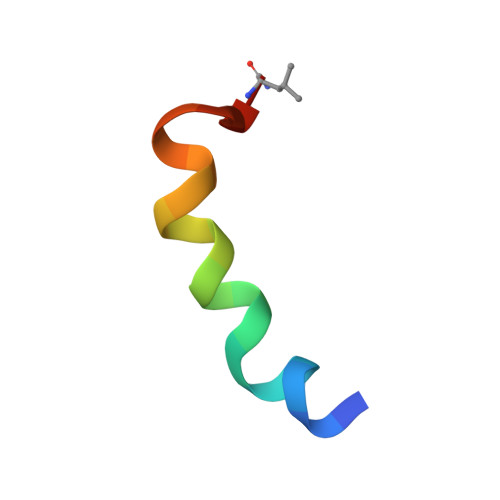The three-dimensional structural surface of two beta-sheet scorpion toxins mimics that of an alpha-helical dihydropyridine receptor segment.
Green, D., Pace, S., Curtis, S.M., Sakowska, M., Lamb, G.D., Dulhunty, A.F., Casarotto, M.G.(2003) Biochem J 370: 517-527
- PubMed: 12429019
- DOI: https://doi.org/10.1042/BJ20021488
- Primary Citation of Related Structures:
1JZP - PubMed Abstract:
An alpha-helical II-III loop segment of the dihydropyridine receptor activates the ryanodine receptor calcium-release channel. We describe a novel manipulation in which this agonist's activity is increased by modifying its surface structure to resemble that of a toxin molecule. In a unique system, native beta-sheet scorpion toxins have been reported to activate skeletal muscle ryanodine receptor calcium channels with high affinity by binding to the same site as the lower-affinity alpha-helical dihydropyridine receptor segment. We increased the alignment of basic residues in the alpha-helical peptide to mimic the spatial orientation of active residues in the scorpion toxin, with a consequent 2-20-fold increase in the activity of the alpha-helical peptide. We hypothesized that, like the native peptide, the modified peptide and the scorpion toxin may bind to a common site. This was supported by (i) similar changes in ryanodine receptor channel gating induced by the native or modified alpha-helical peptide and the beta-sheet toxin, a 10-100-fold reduction in channel closed time, with a < or = 2-fold increase in open dwell time and (ii) a failure of the toxin to further activate channels activated by the peptides. These results suggest that diverse structural scaffolds can present similar conformational surface properties to target common receptor sites.
Organizational Affiliation:
Division of Molecular Bioscience, John Curtin School of Medical Research, Australian National University, P.O. Box 334, Canberra, ACT, 2601, Australia.













